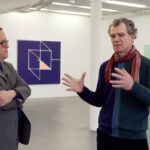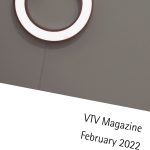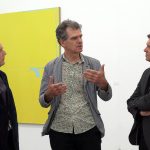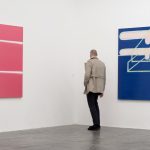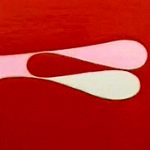Miguel Abreu Gallery in New York is currently showing a solo exhibition with works by Paul Pagk. The show features twelve large-scale paintings and thirteen works on paper. It’s Paul Pagk’s first one-person exhibition at the gallery. The show is held at the gallery’s 88 Eldridge Street space and runs until March 5, 2023.
In this video we have a look at the exhibition on the occasion of the opening reception on January 12, 2023. An upcoming video features a conversation between Paul Pagk and Miguel Abreu.
Paul Pagk / Miguel Abreu Gallery, New York. Opening reception, January 12, 2023.
Right-click (Mac: ctrl-click) this link to download Quicktime video file.
Press text (excerpt):
Even for viewers only glancingly acquainted with his work, a painting by Paul Pagk is instantly identifiable as such. Pagk achieves this recognizability not from any trademark image or eccentric technique or unconventional material, but, rather, from a constellation of factors, including an emphatically linear style of abstraction; a subtle and, I suspect, deeply engrained sense of formal proportion; a color palette that manages to be at once muted and declarative, and distinctive facture in which a seemingly infinite number of brushstrokes establish a palpable materiality while doing their best not to draw attention to themselves. Yet attention, his and ours, is what Pagk’s paintings are all about—this is slow painting at its purest—and as one begins to look more attentively at any group of this artist’s canvases, such as the paintings on view here, nearly all of them made over the last three years, another aspect of his work emerges: a radical variety. If the word “radical” seems exaggerated, I urge you to return to his work and notice how each painting appears to have begun with a different question, a different visual idea, a different mood, a different kind of internal weather, and how each finished canvas then proposes an utterly unique solution, albeit one that adopts a stance of openness and self-questioning.
Look, for instance, at how various his lines can be. In MidNoon 2 (2021), the white lines that spread a geometrical web across the square, powdery blue canvas are slender and materially insubstantial like chalk markings on a blackboard or delicate indications on a blueprint. By contrast, the stack of three clunky structures in And Thus Spoke (2020) are formed from more substantial lines suggestive of old rooftop TV antennas or bent rebar. In Refraction (2022) the red and yellow lines spanning the field of verdigris evoke lengths of taut yarn. An altogether different approach is visible in The Pier (2021) where an openwork geometric structure is indicated by multiple uneven dragged brushstrokes that are just barely kept in place by conduit-like channels of paint.
Studying the paintings in this show, trying to figure out why, despite the types of differences I have been enumerating, they are all so clearly the work of a single artist, I discovered at least one common compositional property: every one of Pagk’s linear structures is attached in one or more places to an edge of the painting. But then I looked at Refraction again and my neat theory collapsed—nowhere do its yellow and red lines touch the painting’s edges. I’m sure that I’m not alone among Pagk’s audience to want to discover some underlying logic in his work. A better way to put it might be to say that Pagk is an artist who invites the viewer to join him in pursuit of meaning. For him, the work is an occasion for meditation and an object of thinking.
Like any compelling artist, Pagk draws on multiple and contradictory influences. His commitment to a figure/ground abstraction that embraces traditional materials and techniques—oil paint (which he makes himself) applied to canvas with a brush—connects him with an earlier wave of artists who emerged in the 1980s—Mary Heilmann, Jonathan Lasker, Tom Nozkowski—but his work has a stripped-down quality, a quietness, that is rare among these painters, who were concerned to distance themselves from the Minimalist abstraction of the 1960s and 1970s. What Pagk keeps his distance from is any hint of vernacular, pop or decorative imagery, which attracted so many artists, including not a few abstract painters, in the 1980s. If there is one thing that sets Pagk apart from the majority of his contemporaries it is that he apparently feels no need to frame his paintings with irony.
John Ashbery’s poem “No Way of Knowing” begins, “And then? Colors and names of colors.”[i] Those last five words encapsulate not only the gap between what happens in a painting and what we might say or write about it, but also the epistemological difference between knowledge and its codification. There is a diagrammatic quality to Pagk’s paintings, but for all their precision and specificity, it is hard to identify what it is they diagram. It’s tempting to describe them as diagrams of themselves, but I don’t believe that Pagk’s work is ultimately tautological. There are simply too many echoes of the world beyond the painting (hence, maybe, why nearly all of Pagk’s linear structures nudge the edges of their supports in a rejection of any hermeticism) and the breadth of human history. I look at the earliest painting in the show, La Notte (2015), and I think of Abu Rayhan al-Biruni’s drawing of the phases of the Moon created in the year 1019 CE or Roger Bacon’s optic studies from the 13th century or the lines on a basketball court or the perspectival drawing of an escalator, and yet each time I come close to a moment of recognition, of identification, the painting reasserts its “pictorial ambiguity” and I find myself taking in the brushstrokes glistening in the velvety violet ground (can velvet glisten?) or puzzling out how this obviously off-center composition seems to depend on its central point that has no more weight than a whisper. Similar journeys can be launched from and within any of the paintings in this show, voyages that begin where our words end.
– Raphael Rubinstein
A display of publications by Raphael Rubinstein will be featured in our bookstore for the duration of the exhibition. It includes A Geniza, a limited edition artist book subtitled “a poem of fragmented fragments pertaining to Edmond Jabès, Uum Kalsoum, Leila Mourad and other former and current citizens of Cairo, Egypt.” The work delves into the history of Cairo as a multi-ethnic, cosmopolitan and contested site.
Paul Pagk (b. 1962, Crawley, UK) lives and works in New York City. Institutional surveys of his work were recently on view at the Centre d’Arts Plastiques, Royan (2022) and the Fondation Fernet-Branca, Saint-Louis (2021), both in France. He had solo exhibitions at Galerie Jean Fournier, Paris (1987), Thread Waxing Space, New York (1991 & 1993), CRG Gallery, New York (1994 & 1995), C.R.A.C. Montbéliard, France (1999), Markus Winter, Berlin (2007), Baukunst Galerie, Cologne (2008), Galerie Eric Dupont, Paris (2014 & 2019), among others. His work was included in Singing in Unison: Artists Need to Create On the Same Scale That Society Has the Capacity to Destroy, curated by Phong H. Bui at Miguel Abreu Gallery, New York (2022). Pagk’s work is held in the permanent collections of the Fonds National d’Art Contemporain (FNAC), Paris; Les Abattoirs, Toulouse, Fonds Régional d’Art Contemporain (FRAC), Picardie, France, Springfield Museum of Art, OH, Hood Museum of Art, Dartmouth College, NH, among others.
[i] John Ashbery, “No Way of Knowing,” in Self-Portrait in a Convex Mirror, Viking Press, New York, 1975, p. 55.
